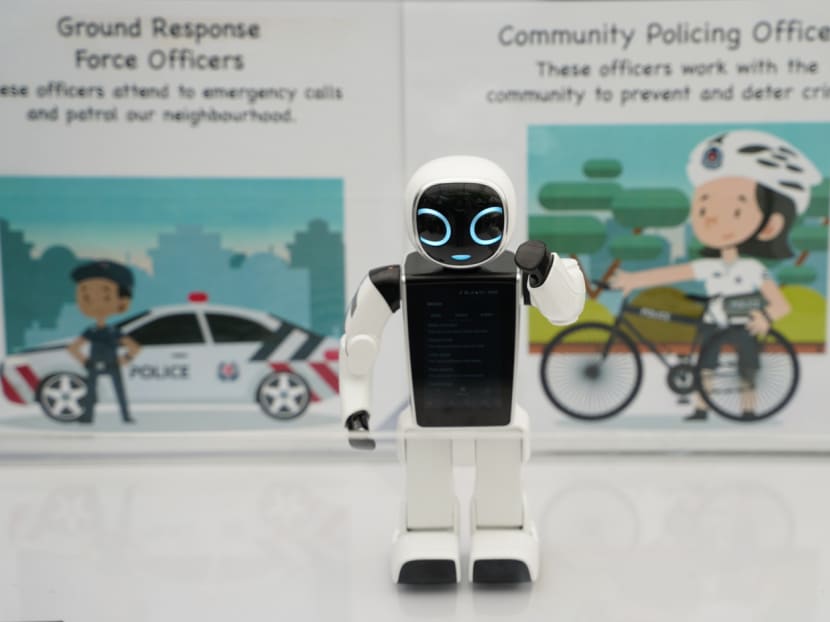Kindergarten robocop and drones among new tools to support Singapore police
SINGAPORE — Singapore’s police officers regularly visit preschools to teach children about crime prevention, but they often face a little hitch — kids tend to cry when faced with a real-life policeman.

The Mini Autonomous School Talk Robot Officer (Mi-Astro) was among the new technologies unveiled by the Singapore Police Force at its annual workplan seminar on Thursday (April 11).
SINGAPORE — Singapore’s police officers regularly visit preschools to teach children about crime prevention, but they often face a little hitch — kids tend to cry when faced with a real-life policeman.
Now the police have help in the form of a miniature humanoid robot, about the size of a water bottle, which can perform somersaults and spew crime prevention messages in a kid-friendly way.
The robot, called the Mini Autonomous School Talk Robot Officer (Mi-Astro), was among the new technologies unveiled by the Singapore Police Force at its annual Police Workplan Seminar on Thursday (April 11).
Like Mi-Astro, which has only been in use since earlier this year, most of these technologies are still being tested out on the field.
Here is a look at some of them:
ENHANCED USE OF AERIAL DRONES
The police force has a new unit that deploys unmanned aerial vehicles (UAV), or drones, to support other units on the ground.
The drones are operated by a 10-man SPF UAV unit, set up in October last year, that can be deployed in situations such as crowd management or search and rescue operations.
The drones can be used both indoors and outdoors.
When deployed, the unit will control the drones from a modified police van nearby. The drones can fly for as long as 40 minutes, up to heights of a few hundred metres above ground level.
They can even be used to fly near a unit in a high-rise building where an incident is taking place, to capture live video, which can be streamed back to the Police Operations Command Centre.
“When we push out the UAVs, the frontline commanders will have a better sense of the incident as it develops, to help them in making ground decisions as well as to coordinate the frontline response resources,” said Senior Assistant Commissioner How Kwang Hwee, director of operations.
At the moment, the unit has one van on trial for one year. It will be deployed at pre-planned security events and to respond to incidents at various police divisions.
ROBO-COPS OF THE FUTURE
The police also unveiled two updated versions of their Multi-Purpose All Terrain Autonomous Robot (MATAR 3.0).
One version is equipped with an extendable camera and can perform elevated surveillance from a height of two metres.
The other version features a tethered unmanned aerial vehicle that can provide aerial surveillance up to a height of 30 metres.
The previous version of MATAR could only provide surveillance at a fixed height.
The police are also exploring wearable technology such as smart glasses — equipped with facial recognition technology — which can be used to perform real-time video analytics, and will deploy them at upcoming major security events to test their effectiveness.
TRAINING GOES HI-TECH
To supplement existing training programmes, the police are exploring two new systems that will enhance police defence tactics and marksmanship training.
The Impact Measurement Trainer will provide immediate feedback to trainees striking a mannequin with their limbs or batons — by displaying information such as the strength and location of each strike on a screen next to the mannequin.
This will enable the trainee and instructor to take corrective actions to improve the application of techniques, the police said.
The police are also co-developing an Enhanced Live Firing Range System with the Science & Technology Group, which will provide real-time recommendations to help officers improve their shooting at live firing ranges.
It will analyse factors such as weapon handling, breathing and posture.
STREAMLINED SCREENING
The police have also rolled out a one-stop screening platform to all their investigation officers since March.
The platform, called Jarvis, was developed in collaboration with GovTech. It allows investigation officers to make faster and better searches across multiple police databases with a single query.
The system has “tiered and regulated access” to ensure that only appropriate screenings are made, the police said.
Previously, investigation officers had to log on to multiple screening systems to conduct searches, such as personal information of individuals, on different police databases.
With Jarvis, screening that used to take about 20 minutes now only takes up to five minutes.









